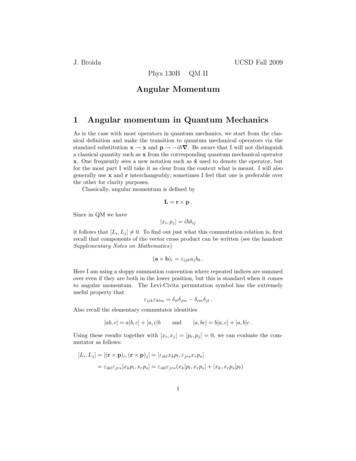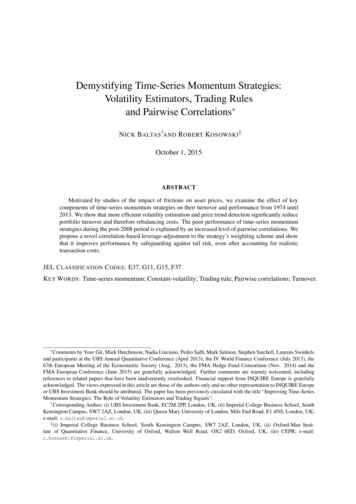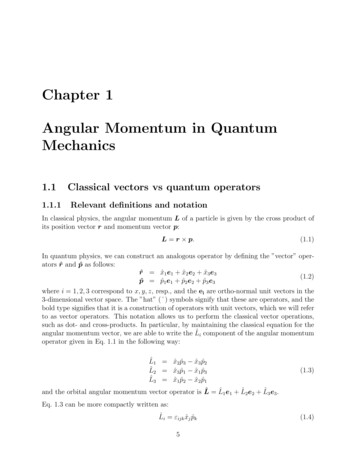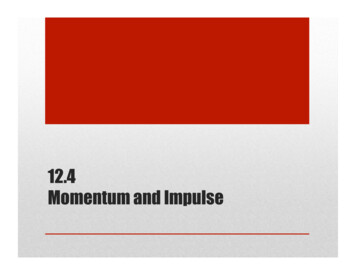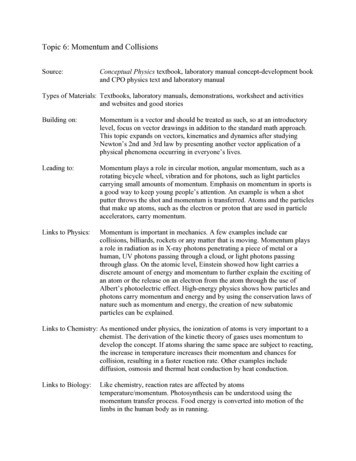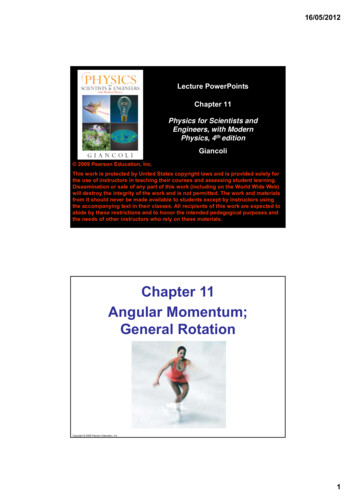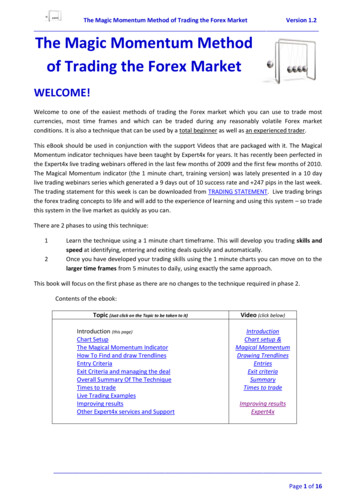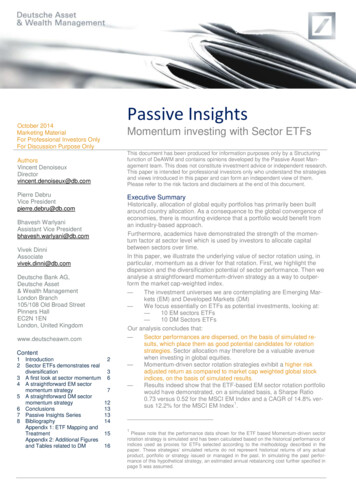
Transcription
Momentum Strategies in Futures Marketsand Trend-Following Funds A KINDYNOS -N IKOLAOS BALTAS†AND ROBERT KOSOWSKI‡First Version: December 10, 2011This Version: February 14, 2013ABSTRACTIn this paper, we rigorously establish a relationship between time-series momentum strategiesin futures markets and commodity trading advisors (CTAs), a subgroup of the hedge fund universethat has grown to 300 billion and has attracted significant attention during the recent financial crisis. Building on this relationship, we examine the question of capacity constraints in trend-followinginvesting. Using a cross-section of 71 futures contracts over the period 1974-2012, we first construct one of the most comprehensive sets of time-series momentum portfolios across various tradingfrequencies. Second, we provide evidence that CTAs follow time-series momentum strategies, byshowing that such benchmark strategies have high explanatory power in the time-series of CTA index returns. Third, based on this result, we investigate whether there exist capacity constraints intime-series momentum strategies. Consistent with the view that futures markets are relatively liquid, we do not find evidence of statistically significant capacity constraints when using two differentmethodologies and several robustness tests. Our results have important implications for hedge fundstudies and investors.JEL C LASSIFICATION C ODES : E3, G14.K EY W ORDS : Trend-following; Momentum; Managed Futures; CTA; Capacity Constraints. The comments by Doron Avramov, Yoav Git, Antti Ilmanen, Lars Norden, Lasse Pedersen, Stephen Satchell, BerndScherer, Michael Streatfield and Laurens Swinkels are gratefully acknowledged. We also thank conference participants at theEuropean Financial Management Association (EFMA) annual meeting (June 2012), the INQUIRE Europe Autumn Seminar(Oct. 2012), the Annual Conference on Advances in the Analysis of Hedge Fund Strategies (Dec. 2012) and the InternationalEUROFIDAI-AFFI Paris Finance Meeting (Dec. 2012) and seminar participants at the Oxford-Man Institute of QuantitativeFinance, the Hebrew University of Jerusalem, the University of New South Wales, the University of Sydney Business School,the University of Technology, Sydney, Waseda University, QMUL, and Manchester Business School. Comments are warmlywelcomed, including references to related papers that have been inadvertently overlooked. Financial support from INQUIREEurope and the BNP Paribas Hedge Fund Centre at SMU is gratefully acknowledged.† Corresponding Author; Imperial College Business School, South Kensington Campus, London, United Kingdom;n.baltas@imperial.ac.uk.‡ Imperial College Business School, South Kensington Campus, London, United Kingdom; r.kosowski@imperial.ac.uk.
1. IntroductionIn this paper, we rigorously study the relationship between time-series momentum strategies in futuresmarkets and commodity trading advisors (CTAs), a subgroup of the hedge fund universe that was one ofthe few profitable hedge fund styles during the financial crisis of 2008, hence attracting much attentionand inflows in its aftermath.1 Following inflows over the subsequent years, the size of the industry hasgrown substantially and exceeded 300 billion of the total 2 trillion assets under management (AUM)invested in hedge funds by the end of 2011, with CTA funds2 accounting for around 10%-15% of thetotal number of active funds (Joenväärä, Kosowski and Tolonen 2012).However, the positive double-digit CTA returns in 2008 have been followed by disappointing performance. Could this be due to the presence of capacity constraints, despite the fact that futures marketsare typically considered to be relatively liquid? A recent Financial Times article3 observes about CTAsthat: “Capacity constraints have limited these funds in the past. [.] It is a problem for trend-followers:the larger they get, the more difficult it is to maintain the diversity of their trading books. While equityor bond futures markets are deep and liquid, markets for most agricultural contracts -soy or wheat, forexample- are less so”. To our knowledge, the hypothesis of capacity constraints in strategies followedby CTAs has not been examined rigorously in the academic literature. Our objective is, therefore, tocarefully examine the question of capacity constraints in trend-following investing.Our paper makes three main contributions. First, in order to rigorously test for capacity constraintsin trend-following strategies, we establish a relationship between time-series momentum strategies andCTA fund performance. Managed futures strategies have been pursued by CTAs since at least the 1970s,shortly after futures exchanges increased the number of traded contracts (Hurst, Ooi and Pedersen 2010).Covel (2009) claims that the main driver of such strategies is trend-following –that is, buying assetswhose price is rising and selling assets whose price is falling– but he does not carry out tests usingreplicating momentum portfolios, in order to substantiate this statement. Building on recent evidence ofmonthly time-series momentum patterns (Moskowitz, Ooi and Pedersen 2012) and on the fact that CTAfunds differ in their forecast horizons and trading activity –long, medium and short-term– (Hayes 2011,Arnold 2012), we construct one of the most comprehensive sets of time-series momentum portfolios over1 TheFinancial Times, March 13, 2011, “CTAs: “true diversifiers” with returns to boot”, by Steve Johnson.funds are also known as managed futures funds.3 The Financial Times, November 27, 2011, “Winton’s head is a proud speculator”, by Sam Jones.2 CTA1
a broad grid of lookback periods, investment horizons and frequencies of portfolio rebalancing.Using Moskowitz et al.’s (2012) methodology and data on 71 futures contracts across assets classesfrom December 1974 to January 2012, we not only document the existence of strong time-series momentum effects across monthly4 , weekly and daily frequencies, but also confirm that strategies with differentrebalancing frequencies have low cross-correlations and therefore capture distinct return patterns. Themomentum patterns are pervasive and fairly robust over the entire evaluation period and within subperiods. The different strategies achieve annualised Sharpe ratios of above 1.20 and perform well in up anddown markets, which renders them good diversifiers in equity bear markets in line with Schneeweis andGupta (2006). Furthermore, commodity futures-based momentum strategies have low correlation withother futures strategies, despite the fact that they have a relatively low return, thus providing additionaldiversification benefits. We also find that momentum profitability is not limited to illiquid contracts. Inaddition to this observation, we note that that such momentum strategies are typically implemented bymeans of exchange traded futures contracts and forward contracts, which are considered to be relativelyliquid and to have relatively low transaction costs compared to cash equity or bond markets. Therefore,for simplicity, we do not incorporate transaction costs into the momentum strategies that we study.Second, using a representative set of momentum strategies across various rebalancing frequencies,we investigate, by means of time-series analysis, whether CTA funds are likely to employ such strategiesin practice.5 We find that the regression coefficients of a CTA index on monthly, weekly and dailytime-series momentum strategies are highly statistically significant. This result remains robust aftercontrolling for standard asset pricing factors (such as the Fama and French’s (1993) size and value factorsand Carhart’s (1997) cross-sectional momentum factor) or the Fung and Hsieh (2001) straddle-basedprimitive trend-following factors. Interestingly, the inclusion of the time-series strategies among thebenchmark factors of the Fung and Hsieh (2004) model for hedge fund returns dramatically increases itsexplanatory power, while the statistical significance of some of the straddle factors is driven out.One explanation for this result may be related to advantages that our time-series momentum strategiesexhibit relative to the lookback straddle factors that Fung and Hsieh (2001) introduce in their pioneering4 Moskowitzet al. (2012) also document monthly time-series momentum profitability using 58 futures contracts over theperiod January 1985 to December 2009.5 Our objective is not to provide cross-sectional pricing tests based on CTA returns, but instead to show whether CTA fundsdo in practice employ time-series momentum strategies, or, in other words, whether such strategies do proxy for the tradingactivity of CTA funds.2
work on benchmarking trend-following managers. First, our time-series momentum strategies offer aclear decomposition of different frequencies of trading activity. Second, by using futures as opposedto options, our benchmarks represent a more direct approximation of the futures strategies followedby many trend-following funds.6 Overall, our results represent strong evidence that the historical outperformance of the CTA funds is statistically significantly related to their employment of time-seriesmomentum strategies using futures contracts over multiple frequencies.Our third and final contribution is in the form of tests for the presence of capacity constraints intrend-following strategies that are employed by CTAs. In principle, there are many different ways ofdefining capacity constraints and testing for them. We choose two different methodologies in order torobustify our findings. The first methodology is based on performance-flow predictive regressions. Weshow that lagged fund flows into the CTA industry have not historically had a statistically significanteffect on the performance of time-series momentum strategies. The regression coefficient of lagged CTAflows is, on average, negative but statistically insignificant. Furthermore, a conditional study revealsthat the relationship exhibits time-variation, including occasional switches in the sign of the predictiverelationship over time. The unconditionally negative (though insignificant) fund flow effect that wedocument is consistent with Berk and Green (2004), Naik, Ramadorai and Stromqvist (2007), Aragon(2007) and Ding, Getmansky, Liang and Wermers (2009). These findings hold for all asset classes,including commodities-based momentum strategies, contrary to the quote from the Financial Times thatwe used above as a motivating statement.The second methodology is based on a thought experiment in which we simulate what would happenunder the extreme assumption that the entire AUM of the systematic CTA industry were invested in atime-series momentum strategy. We find that for most of the assets, the demanded number of contractsfor the construction of the strategy does not exceed the contemporaneous open interest reported by theCommodity Futures Trading Commission (CFTC) over the period 1986 to 2011. This lack of exceedancecan be interpreted as evidence against capacity constraints in time-series momentum strategies. In arobustness check, we also find that the notional amount invested in futures contracts in this hypotheticalscenario is a small fraction of the global OTC derivatives markets (2.3% for commodities, 0.2% forcurrencies, 2.9% for equities and 0.9% for interest rates at end of 2011). Overall, the findings from both6 According to practitioners that we talked to, one reason for why futures-based strategies are more popular than lookbackstraddles among CTAs is that the former are cheaper to implement.3
methodologies suggest that the futures markets are liquid enough to accommodate the trading activity ofthe CTA industry, in line with Brunetti and Büyükşahin (2009) and Büyükşahin and Harris (2011).Our paper is related to three main strands of the literature. First, it is related to the literature onfutures and time-series momentum strategies. As already discussed, Moskowitz et al. (2012) carry outone of the most comprehensive analyses of “time-series momentum” in equity index, currency, bondand commodity futures. Szakmary, Shen and Sharma (2010) also construct trend-following strategiesusing commodity futures, whereas Burnside, Eichenbaum and Rebelo (2011) examine the empiricalproperties of the payoffs of carry trade and time-series momentum strategies. It is important to stressthat time-series momentum is distinct from the “cross-sectional momentum” effect that is historicallydocumented in equity markets (Jegadeesh and Titman 1993, Jegadeesh and Titman 2001), in futuresmarkets (Pirrong 2005, Miffre and Rallis 2007), in currency markets (Menkhoff, Sarno, Schmeling andSchrimpf 2012) and, in fact, “everywhere” (Asness, Moskowitz and Pedersen 2012).Second, our findings of time-series return predictability in a univariate and portfolio level pose asubstantial challenge to the random walk hypothesis and the efficient market hypothesis (Fama 1970,Fama 1991). The objective of this paper is not to explain the underlying mechanism, but there areseveral theoretical explanations of price trends in the literature based on rational (e.g.Berk, Greenand Naik 1999, Chordia and Shivakumar 2002, Johnson 2002, Ahn, Conrad and Dittmar 2003, Sagiand Seasholes 2007, Liu and Zhang 2008) and behavioural approaches (e.g.Barberis, Shleifer andVishny 1998, Daniel, Hirshleifer and Subrahmanyam 1998, Hong and Stein 1999, Frazzini 2006) to serialcorrelation in asset return series. Price trends may, for example, be due to behavioural biases exhibitedby investors, such as herding or anchoring, as well as trading activity by non-profit seeking marketparticipants, such as corporate hedging programs and central banks. Adopting a different perspective,Christoffersen and Diebold (2006) and Christoffersen, Diebold, Mariano, Tay and Tse (2007) show thatthere exists a link between volatility predictability and return sign predictability even when there exists noreturn p
in trend-following strategies, we establish a relationship between time-series momentum strategies and CTA fund performance. Managed futures strategies have been pursued by CTAs since at least the 1970s, shortly after futures exchanges increased the number of traded contracts (Hurst, Ooi and Pedersen 2010). Covel (2009) claims that the main driver of such strategies is trend-following –that .

